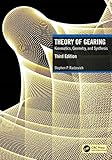Theory of Gearing : Kinematics, Geometry and Synthesis / Stephen R. Radzevich
Material type: TextPublication details: Boca Raton CRC Press 2023Edition: 3rd EdDescription: xxxviii, 1153p. : ill. ; 26cmISBN:
TextPublication details: Boca Raton CRC Press 2023Edition: 3rd EdDescription: xxxviii, 1153p. : ill. ; 26cmISBN: - 9781032318578
- 23rd 621.833 RAD
| Item type | Current library | Collection | Call number | Status | Notes | Date due | Barcode | |
|---|---|---|---|---|---|---|---|---|
| Reference Book | VIT-AP General Stacks | Reference | 621.833 RAD (Browse shelf(Opens below)) | Not For Loan (Restricted Access) | MECH | 020349 | ||
| Text Book | VIT-AP General Stacks | 621.833 RAD (Browse shelf(Opens below)) | Available | MECH | 020350 | |||
| Text Book | VIT-AP General Stacks | 621.833 RAD (Browse shelf(Opens below)) | Available | MECH | 020351 |
Browsing School of Mechanical Engg Section shelves, Shelving location: General Stacks, Collection: Reference Close shelf browser (Hides shelf browser)

|

|

|

|

|

|

|
||
| 621.815 ULL The Mechanical Design Process / | 621.81505 Schaum's Outline Machine Design | 621.83 Handbook of Gear Design | 621.833 RAD Theory of Gearing : Kinematics, Geometry and Synthesis / | 621.89 Fundamentals of Engineering and Tribology with Applications | 621.89 Theory of Lubrication | 621.89 SHA Tribology |
It includes Appendix, Glossary and Index Pages.
Description:
Updated throughout for the third edition, Theory of Gearing: Kinematics, Geometry, and Synthesis is an essential resource for engineers in the field of gearing. Detailing gear design, production, inspection, and application, the book covers cutting-edge gear types to enable the reader to fully keep track of modern gear developments.
Demonstrating the rigorous scientific theory behind optimal gear design, manufacture, and performance, a key focus of the new edition is on aiding engineers in designing low noise transmissions in smaller sizes, improving fuel consumption and reducing emissions. Chapters included will discuss key features of Split-Power-Transmission-Systems (SPTS) with equal (almost equal) power share, and Uniform Rotary Motion. Entirely new chapters for the third edition include: Parallel-Axes involute gearing of specific design and gear, and Novikov/Conformal and High-Conformal gearing.
The book will be of interest to engineers and researchers in the gearing industry. It will also have relevance to those working in tribology, metallurgy, and materials processing, alongside engineers working in precision manufacturing.
Table of Contents:
Introduction 1. Non-Involute Gearing Part I: Fundamentals 2. Kinematics of Gear Pair 3. Principal Planes and Main Reference Systems Associated with Gear Pair 4. Smooth Transmission of Uniform Rotary Motion: Three Fundamental Laws of Gearing 5. Permissible Variation of the Design Parameters in Equivalent Pulley-and-Belt Transmission Part II: Geometrically-Accurate Gearing Section II-A: GEOMETRICALLY-ACCURATE GEARING: Parallel-Axes Gearing 6. Involute Gearing: Kinematics and Geometry 7. Simplified Approach to Generation of Involute Gear Tooth Flank 8. Parallel-Axes Involute Gearing of Specific Design 9. Gear Tooth Profile Modification: Generating Rack Shift 10. Interaction of Tooth Flanks in Parallel-Axes Involute Gearing 11. Novikov/Conformal and High-Conformal Gearing Section II-B: GEOMETRICALLY-ACCURATE GEARING: Intersected-Axes Gear Pairs 12. Geometrically-Accurate Intersected-Axes Gear Pairs 13. Interaction of Tooth Flanks in Geometrically-Accurate Intersected-Axes Gearing Section II-C: GEOMETRICALLY-ACCURATE GEARS: Crossed-Axes Gearing 14. Geometrically-Accurate Crossed-Axes Gear Pairs: R-Gearing 15 Interaction of Gears in Geometrically-Accurate Crossed-Axes Gearing 16. Geometrically-Accurate Worm-Gearing: Peculiarities of Kinematics and Geometry Part III: Real Gears: Kinematics, Geometry, and Application 17. Geometrically-Accurate Real Gearing: pr S Gear System Part IV: C∑u Variable Gearing 18. C∑u Variable Gears: Kinematics, Geometry, and Novel Concept to Design Geometrically-Accurate Gears Part V: On Synthesizing of Favorable Geometrically-Accurate Gear Pairs 19. Features of Contact Geometry Part VI: Real Gears and Their Application 20. Generic Gear Surfaces 21. Approximate Real Gearing 22. Local Geometry of Interacting Gear Tooth Flanks 23. Strength of Gear Teeth 24. SPTS – Split Power Transmission Systems 25. Vector Approach in Kinematic and Dynamic Analysis of Complex Gear Transmission Systems 26. Gear Ratio of Multistage Gear Transmission System 27. Gear Accuracy 28. Gear Noise and Vibration 29. Design Peculiarities of Geometrically-Accurate and Almost Geometrically-Accurate Gears 30. A Brief Overview on Evolution of the Scientific Theory of Gearing 31. On the Lack of Understanding of the Scientific Theory of Gearing by the Majority of Gear Scientists and Engineers
There are no comments on this title.

